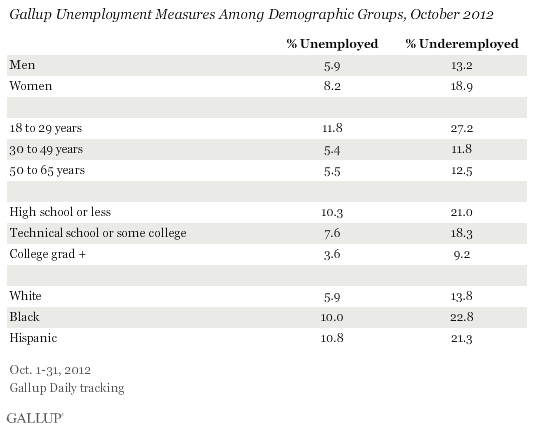WASHINGTON, D.C. -- U.S. unemployment, as measured by Gallup without seasonal adjustment, fell to 7.0% for the month of October, down significantly from the 7.9% measured at the end of September. Gallup's seasonally adjusted unemployment rate is 7.4%, improved more than a half a point from September.

These results are based on Gallup Daily tracking interviews, conducted by landline and cell phone, with approximately 30,000 Americans throughout the month -- 68.3% of whom in October reported being active in the workforce. The monthly average for October excludes Oct. 29 and Oct. 30, the two days that Gallup did not poll because of the effects of Superstorm Sandy on the East Coast. Gallup calculates a seasonally adjusted unemployment rate by applying the adjustment factor the government used for the same month in the previous year. For October, Gallup applied the .04 upward adjustment the government used last year.
Seasonally unadjusted unemployment of 7.0% is the lowest Gallup has recorded since it began collecting unemployment data in January 2010. It is also more than a full point and a half improvement over the October 2011 rate, when unadjusted unemployment was 8.4%. The size of the workforce, which can influence employment rates, was little changed, at 68.3%, from 68.2% in September.
Underemployment, as measured without seasonal adjustment, was 15.9% in October, an improvement since the end of September and a significant decline from 17.8% a year ago. This is the lowest underemployment rate since Gallup started collecting underemployment data in 2010.
Gallup's U.S. underemployment measure combines the percentage who are unemployed with the percentage of those working part time but looking for full-time work. Gallup does not apply a seasonal adjustment to underemployment.
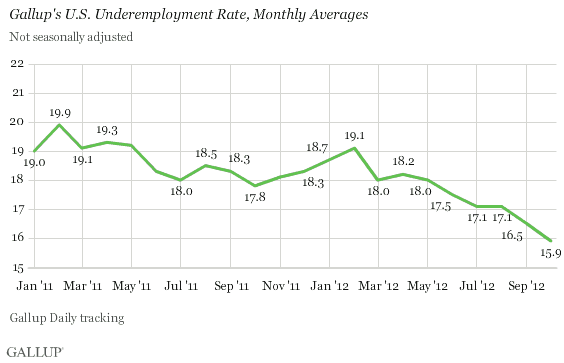
Although underemployment improved during October, the number of part-timers wanting full-time work increased to 8.9%, up from 8.6% in September. Part-time hiring generally picks up during the holiday season, so many previously unemployed members of the workforce may now be working part-time jobs but still desiring permanent, full-time employment. This is likely why the government adjusted its unemployment rate up 0.4 points in October.
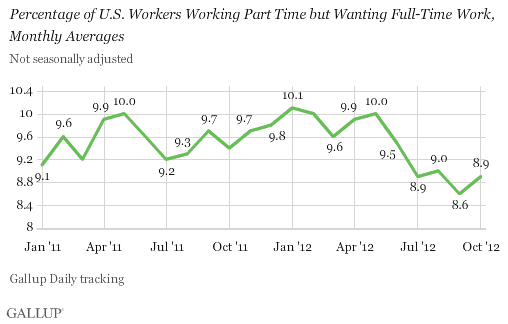
Implications
Gallup's decline in seasonally adjusted unemployment, the closest comparison to the official numbers released by the U.S. Bureau of Labor Statistics (BLS), suggests that the BLS will report another decline in the unemployment rate when it releases the numbers on Friday.
Holiday sales are expected to improve over last year, which could be contributing to some of the increased hiring this year. Unless a significant number of permanent jobs are added in the coming months, unadjusted unemployment will increase again in early 2013 as seasonal jobs end. Still, the decline in seasonally adjusted unemployment and year-over-year unadjusted unemployment are a promising sign that more Americans are finding the work they desire.
Editor's Note: The October 2012 data in the table below in some cases reflect a revision of 0.1 points from the original version.
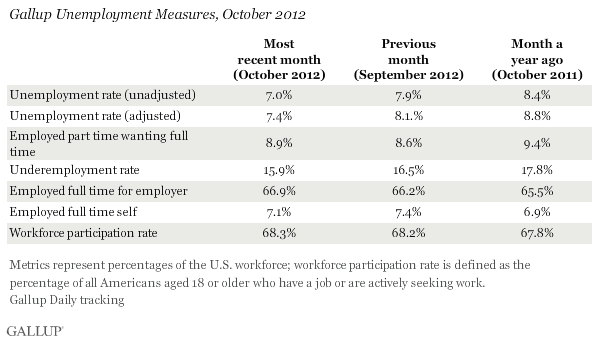
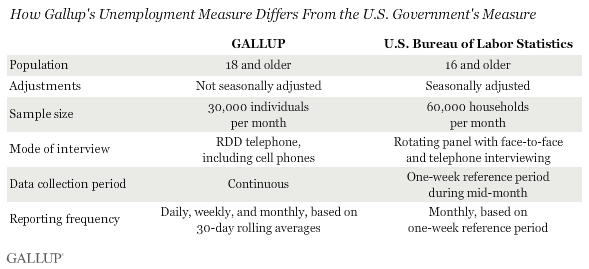
Gallup.com reports results from these indexes in daily, weekly, and monthly averages and in Gallup.com stories. Complete trend data are always available to view and export in the following charts:
Daily: Employment, Economic Confidence, Job Creation, Consumer Spending
Weekly: Employment, Economic Confidence, Job Creation, Consumer Spending
Read more about Gallup's economic measures.
View our economic release schedule.
Survey Methods
Results are based on telephone interviews conducted as part of the Gallup Daily tracking survey Oct. 1-31, 2012, with a random sample of 28,295 adults, aged 18 and older, living in all 50 U.S. states and the District of Columbia, selected using random-digit-dial sampling.
For results based on the total sample of [national adults/registered voters], one can say with 95% confidence that the maximum margin of sampling error is ±1 percentage point.
Interviews are conducted with respondents on landline telephones and cellular phones, with interviews conducted in Spanish for respondents who are primarily Spanish-speaking. Each sample includes a minimum quota of 400 cell phone respondents and 600 landline respondents per 1,000 national adults, with additional minimum quotas among landline respondents by region. Landline telephone numbers are chosen at random among listed telephone numbers. Cell phone numbers are selected using random-digit-dial methods. Landline respondents are chosen at random within each household on the basis of which member had the most recent birthday.
Samples are weighted by gender, age, race, Hispanic ethnicity, education, region, adults in the household, and phone status (cell phone only/landline only/both, cell phone mostly, and having an unlisted landline number). Demographic weighting targets are based on the March 2011 Current Population Survey figures for the aged 18 and older non-institutionalized population living in U.S. telephone households. All reported margins of sampling error include the computed design effects for weighting and sample design.
In addition to sampling error, question wording and practical difficulties in conducting surveys can introduce error or bias into the findings of public opinion polls.
For more details on Gallup's polling methodology, visit https://www.gallup.com/.
